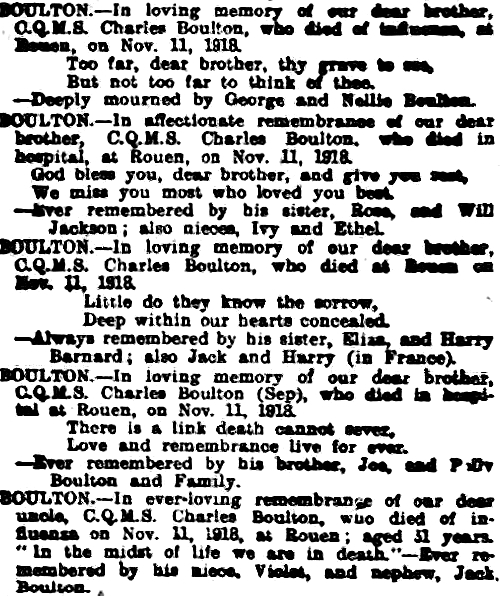
Charles was born about 1887, son of John Boulton and Sarah, formerly Aldridge, probably in the Wilkin area (officially Norton Canes) of Brownhills, Staffordshire. In 1891 4 year old Charles lived at “Wilkin”, where John was a coal miner, as were two older brothers; older sister Rose was a dressmaker’s apprentice.
In 1901, Charles (14) was a colliery horse driver (below ground), among the more dangerous underground occupations. Rose was a fully fledged dressmaker.
By 1911, Charles had moved to Kingsbury, Warwickshire, one of 5 boarders with widow Mrs Susannah Latham. Charles was a coal hewer.
488673 C.Q.M.S. Charles Boulton was among those most unfortunate of men who died on 11 November 1918, the last day of World War One. He served with the 466th Field Company, Royal Engineers. C.Q.M.S. stood for Company Quarter Master Sergeant, the second most senior non-commissioned officer, next to the Company Sergeant Major.

Charles was first deployed to France on 1 March 1915. From 12 May 1915 the 466th (2nd North Midland) Field Company (a Territorial Force formed at Cannock in August 1914) was assigned to the 46th (North Midland) Division. In 1915 the Division saw action in the German liquid fire attack at Hooge (30-31 July) and the attack at Hohenzollern Redoubt (13 October), where they “behaved with distinguished gallantry worthy of the best traditions of the British Army”. Next they were ordered to Egypt.
After just a few days in Egypt, the order was countermanded and they saw out the rest of the war in France and Flanders. In 1916 they were involved in the diversionary attack at Gommecourt; in 1917 several engagements including occupation of the Gommecourt defences (4 March), the German retreat to the Hindenburg Line and the Battle of Hill 70 (15-25 August); in 1918 including the Battles of Cambrai , the Selle and Sambre. (1)
It appears that key roles for the 466th were the erection of telegraph poles and wiring and construction of pontoon bridges, which necessitated recruitment of many horses from Norton Canes and surrounding areas. They also assisted with tunneling, putting their coal mining experience to use. Reparing trenches was also and important role, which could be very exposed to enemy fire, especially snipers. Other work included cutting brushwood, camouflaging, clearing roots and digging firebays. Perhaps the most challenging of tasks was capturing and repairing bridges, such as those at Riquerval and Gorre, where they exposed to intense enemy fire.
“They also carried out repairs on gas blankets and making billets gas proof. These precautions were very necessary as the men of the 466th Field Company found out on the 7th May. The Staffords and two sections of the sappers had their trenches at Lievin bombarded by gas projectiles. 27 sappers had to be placed under medical supervision due to being slightly affected by the gas.” (2)
On Armistice Day, 11 November 1918 the forward units were at Sains-du-Nord. In early January 1919 demobilisation began at Le Cateau.

According to the local press, CQMS Charles Boulton died that day of influenza in hospital at Rouen, France. Charles was awarded the British War and Victory Medals. His widow, Clara, would receive £43 1s. They had married in the first quarter of 1914. There were no children. Charles is commemorated at St Sever Cemetery Extension, Rouen, France.

(1) The Long, Long Trail, The British Army in the Great War of 1914-1918, http://www.longlongtrail.co.uk/army/order-of-battle-of-divisions/46th-north-midland-division/
(2) Much more detail is given in https://www.cannockchasedc.gov.uk/custom/WW1/norton-canes-royal-engineers.html, which focuses on soldiers from Norton Canes.
